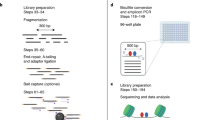Abstract
The bulk of gene expression regulation in most organisms is accomplished through the action of transcription factors (TFs) on cis-regulatory elements (CREs). In eukaryotes, these CREs are generally characterized by nucleosomal depletion and thus higher physical accessibility of DNA. Many methods exploit this property to map regions of high average accessibility, and thus putative active CREs, in bulk. However, these techniques do not provide information about coordinated patterns of accessibility along the same DNA molecule, nor do they map the absolute levels of occupancy/accessibility. SMF (Single-Molecule Footprinting) fills these gaps by leveraging recombinant DNA cytosine methyltransferases (MTase) to mark accessible locations on individual DNA molecules. In this chapter, we discuss current methods and important considerations for performing SMF experiments.
Access this chapter
Tax calculation will be finalised at checkout
Purchases are for personal use only
Similar content being viewed by others
References
Johnson DS, Mortazavi A, Myers RM, Wold B (2007) Genome-wide mapping of in vivo protein-DNA interactions. Science 316(5830):1497–1502
Mikkelsen TS, Ku M, Jaffe DB et al. (2007) Genome-wide maps of chromatin state in pluripotent and lineage-committed cells. Nature 448(7153):553–560
Buenrostro JD, Giresi PG, Zaba LC et al. (2013) Transposition of native chromatin for fast and sensitive epigenomic profiling of open chromatin, DNA-binding proteins and nucleosome position. Nat Methods 10:1213–1218
Crawford GE, Holt IE, Whittle J et al. (2006) Genome-wide mapping of DNase hypersensitive sites using massively parallel signature sequencing (MPSS). Genome Res 16:123–131
Boyle AP, Davis S, Shulha HP et al. (2008) High-resolution mapping and characterization of open chromatin across the genome. Cell 132:311–322
Schones DE, Cui K, Cuddapah S et al. (2008) Dynamic regulation of nucleosome positioning in the human genome. Cell 132(5):887–898
Kelly TK, Liu Y, Lay FD et al. (2012) Genome-wide mapping of nucleosome positioning and DNA methylation within individual DNA molecules. Genome Res 22:2497–2506
Krebs AR, Imanci D, Hoerner L, Gaidatzis D et al. (2017) Genome-wide Single-Molecule Footprinting Reveals High RNA Polymerase II Turnover at Paused Promoters. Mol Cell 67:411–422.e4
Kuhn RM, Haussler D, Kent WJ (2013) The UCSC genome browser and associated tools. Brief Bioinform 14:144–161
Kent WJ, Zweig AS, Barber G et al. (2010) BigWig and BigBed: enabling browsing of large distributed datasets. Bioinformatics 26:2204–2207
Bolger AM, Lohse M, Usadel B. 2014. Trimmomatic: a flexible trimmer for Illumina sequence data. Bioinformatics 30(15):2114–2120
Martin M (2011) Cutadapt removes adapter sequences from high-throughput sequencing reads. EMBnet.Journal 17(1):10–12
Pedersen BS, Eyring K, De S et al. (2014) Fast and accurate alignment of long bisulfite-seq reads. arXiv 1401.1129
Li H, Handsaker B, Wysoker A et al. (2009) The sequence alignment/map format and SAMtools. Bioinformatics 25:2078–2079
SÖnmezer C, Kleinendorst R, Imanci D, Barzaghi G, Villacorta L, Schübeler D, Benes V, Molina N, Krebs AR (2021) Molecular co-occupancy identifies transcription factor binding cooperativity in vivo. Mol Cell 81(2):255–267.e6
Corces MR, Trevino AE, Hamilton EG et al. (2017) An improved ATAC-seq protocol reduces background and enables interrogation of frozen tissues. Nat Methods 14:959–962
Fu Y, Sinha M, Peterson CL, Weng Z (2008) The insulator binding protein CTCF positions 20 nucleosomes around its binding sites across the human genome. PLoS Genet 4(7):e1000138
Acknowledgements
The authors thank members of the Greenleaf, Bintu and Kundaje labs for many helpful discussions. This work was supported by NIH grants (P50HG007735, RO1 HG008140, U19AI057266, and UM1HG009442 to W.J.G., 1UM1HG009436 to W.J.G. and A.K., 1DP2OD022870-01 and 1U01HG009431 to A.K., and HG006827 to C.H.), the Rita Allen Foundation (to W.J.G.), the Baxter Foundation Faculty Scholar Grant, and the Human Frontiers Science Program grant RGY006S (to W.J.G). W.J.G is a Chan Zuckerberg Biohub investigator and acknowledges grants 2017-174468 and 2018-182817 from the Chan Zuckerberg Initiative. Fellowship support provided by the Stanford School of Medicine Dean’s Fellowship (G.K.M.).
Author information
Authors and Affiliations
Corresponding authors
Editor information
Editors and Affiliations
Rights and permissions
Copyright information
© 2023 The Author(s), under exclusive license to Springer Science+Business Media, LLC, part of Springer Nature
About this protocol
Cite this protocol
Hinks, M., Marinov, G.K., Kundaje, A., Bintu, L., Greenleaf, W.J. (2023). Single-Molecule Mapping of Chromatin Accessibility Using NOMe-seq/dSMF. In: Marinov, G.K., Greenleaf, W.J. (eds) Chromatin Accessibility. Methods in Molecular Biology, vol 2611. Humana, New York, NY. https://doi.org/10.1007/978-1-0716-2899-7_8
Download citation
DOI: https://doi.org/10.1007/978-1-0716-2899-7_8
Published:
Publisher Name: Humana, New York, NY
Print ISBN: 978-1-0716-2898-0
Online ISBN: 978-1-0716-2899-7
eBook Packages: Springer Protocols




